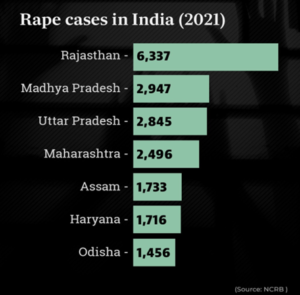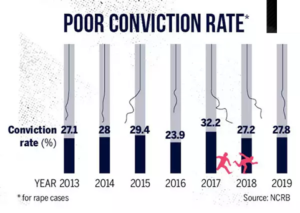THE FATE OF RAPE VICTIMS
Relevance: GS2 – Parliament, Executive, Indian Constitution, Social Issues
Why in the news?
In the Bilkis Bano case, the Supreme Court delivered a noteworthy judgment by nullifying the remission granted to 11 men who were convicted of rape and murder. This distressing incident involved the gangrape of Bilkis Bano and the tragic murder of several members of her family.
Survivors of rape, along with their families, encounter significant challenges within the criminal justice system. The conviction rate in these cases remains strikingly low, allowing many perpetrators to escape legal consequences. Consequently, survivors often find themselves ostracized by their communities, while the perpetrators go unpunished.
Alarming Rise in Rape Cases:
National Crime Records Bureau (NCRB) data reveals a disturbing increase in rape cases across the country. Despite the escalating numbers, justice remains elusive for numerous rape victims.
- India’s Disturbing Safety Ranking: A 2018 Thomson Reuters Foundation survey ranked India as the most dangerous country for women, citing sexual violence, cultural traditions, and human trafficking.
- NCRB data indicates an increase in reported rape cases, averaging 87 cases per day.
- In Rajasthan, there has been a significant 20% surge in reported rape cases since 2020. Shockingly, many victims are minors, including girls as young as six years old.
- Supreme Court’s Role in Justice: The recent Supreme Court verdict in Bilkis Bano’s case is seen as a significant step towards justice for rape survivors, offering hope despite prolonged struggles.
What is the background of the Bilkis Bano case?
- Tragic Events During 2002 Gujarat Riots: Bilkis Bano, pregnant at the time, endured a brutal gangrape. A mob killed seven members of her family, including her three-year-old daughter, during the 2002 Gujarat riots.
- CBI Investigation and Legal Proceedings: The Central Bureau of Investigation (CBI) conducted a thorough investigation into the case. Legal proceedings unfolded as a result of the heinous acts committed during the riots.
- NHRC intervention: In 2003, the judicial magistrate initially closed her case. Undeterred, she sought assistance from the National Human Rights Commission.
- SC Intervention and Trial Transfer: In 2004, the Supreme Court took action due to death threats against Bilkis Bano.
- The case was transferred to the Central Bureau of Investigation (CBI) for a thorough investigation.
- The Supreme Court directed the trial to take place in a special court in Maharashtra to ensure a fair and secure legal process.
- The central government was directed to appoint a special public prosecutor for the case.
- Conviction in 2008: Bilkis Bano endured a challenging 22-year legal battle for justice. In 2008, a Mumbai court handed down convictions to 11 individuals for their roles in the gangrape and murder. This marked a crucial milestone in the pursuit of justice for Bilkis Bano.
- Remission Grant in 2022: In August 2022, the Gujarat government granted remission to the 11 convicted individuals. The release of these convicts raised controversy and prompted legal challenges. Concerns were raised regarding the authority and jurisdiction responsible for granting such remissions, questioning the decision’s validity.
- Jurisdictional Limitations: The Supreme Court’s ruling clarified that Gujarat lacked jurisdiction in the case. Consequently, Gujarat was not authorized to grant remission to the 11 individuals convicted of heinous crimes in this matter.
- Ongoing Safety Concerns for Bilkis Bano: On January 8, the day of the expected Supreme Court verdict, Bano and her family had to relocate due to safety concerns. The move to an undisclosed location reflects the persistent fears for Bano’s safety.
Supreme Court nullifies Gujarat remission
- Lack of Authority and Jurisdiction:
- The Court underscored that the Gujarat government lacked both the authority and jurisdiction to issue remission orders.
- Section 432 of the CrPC grants state governments the power to suspend or remit a sentence, but the court highlighted Section 7(b), emphasizing that the appropriate government is determined by the jurisdiction where the offender is sentenced.
- Specifics of Remission Jurisdiction:
- The court clarified that the decision to grant remission should fall under the jurisdiction of the state where the convicts received their sentence.
- This jurisdictional determination should not be based on the location of the crime or the imprisonment site.
- Critique of Remission Process:
- The Court identified significant flaws in the remission process, highlighting that the orders lacked proper consideration.
- It emphasized that the orders were obtained through the concealment of facts, constituting a form of fraud upon the court.
- Government Overreach Criticized:
- The Court criticized the Gujarat government’s overreach, asserting that it unlawfully exercised power that rightfully belonged to the Maharashtra government in issuing remission orders.
- Directives and Liberty Plea Rejection:
- Rejecting the plea of the convicts to protect their liberty, the Court issued directives.
- The Court directed the convicts to surrender to jail authorities within two weeks, underscoring the legal consequences of the Gujarat government’s unlawful exercise of power.
What is Remission?
- Remission is the complete termination of a sentence at a reduced point.
- Nature of Sentence in Remission: In remission, the nature of the sentence remains unchanged, with the reduction occurring solely in the duration to be served.
- Release Date in Remission: The effect of remission is the assignment of a specific release date for the prisoner. On this date, the individual is considered a free person in the eyes of the law.
- Conditional Release and Consequences: Breach of any remission conditions leads to its cancellation. In such cases, the offender is required to serve the entire term for which they were initially sentenced.
Constitutional Provisions of Remission:
The President’s pardoning power under Article 72 is broader than that of the Governor under Article 161.
Presidential Pardon (Article 72):
- The Constitution grants both the President and Governor the sovereign power of pardon.
- Article 72 empowers the President to grant pardons, reprieves, respites, or remissions of punishment and suspend, remit, or commute sentences. This applies to court-martial punishments, offences under the Union government’s executive power, and death sentences.
Governor’s Pardon Authority (Article 161):
- Article 161 provides the Governor with the authority to grant pardons, reprieves, respites, or remissions of punishment and suspend, remit, or commute sentences.
- This power extends to anyone convicted under laws falling under the State’s executive power.
Statutory Power of Remission:
- Remission under CrPC (Section 432): Section 432 allows the ‘appropriate government’ to suspend or remit a sentence, wholly or partially, with or without conditions.
- Commuted Sentences (Section 433): Section 433 permits the appropriate government to commute any sentence to a lesser one. This statutory power enables state governments to release prisoners before completing their full terms.
Other Rape cases and the systemic issues
Alleged Gangrape Incident at IIT-BHU:
- A B.Tech student at IIT-Benares Hindu University was reportedly gangraped at gunpoint on November 2, 2023, within the university campus.
- The accused were associated with the political party in Varanasi. The assailants stripped the victim and recorded a video to use as blackmail leverage. The victim was subsequently subjected to a violent gangrape.
- Despite knowing the identity of the perpetrators, the police took a week to file an FIR. Initially, the charges were filed under Section 354, related to the use of criminal force against a woman with the intent to outrage her modesty.
- The magistrate’s order compelled the police to amend the FIR to include the appropriate charge of gangrape.
- Arrest and Judicial Custody: Pressured by the student community, the police arrested the accused on December 31. Instead of placing them in police remand for questioning, the accused were placed in judicial custody.
- Lack of Protection for the Victim: The rape victim remains in hiding, without adequate police protection. Concerns persist regarding the safety and well-being of the survivor amid the ongoing legal proceedings.
Bhanwari Devi’s Case:
- Bhanwari Devi, a Dalit in Bhateri village near Jaipur, exemplifies the challenges faced by victims. She was engaged in advocacy against child marriage, she intervened to prevent a nine-month-old baby girl’s marriage in a Gujjar family, considered a ‘higher caste.’
- On September 22, 1992, five members of the Gujjar caste attacked Bhanwari Devi and her husband. Three of the assailants proceeded to rape her in a horrifying act of violence.
- Police Apathy
- Despite the heinous crime, the police initially dismissed Bhanwari Devi’s complaint.
- The medical examination, crucial for evidence, was conducted a staggering 52 hours after the rape occurred.
- Lack of Documentation and Evidence: The medical exam failed to document her scratches and bruises, weakening the case due to insufficient evidence.
- Discrimination in High Court Ruling: In 1995, a High Court judge, reflecting biases against ‘low-caste’ Hindus, dismissed Bhanwari Devi’s case.
- The judge shockingly stated that, due to notions of purity, ‘high-caste’ men would not engage in such acts against a lower-caste woman.
- Systemic Issues in Justice system:
- Bhanwari Devi’s case underscores systemic issues, including police apathy, delayed justice, and caste-based prejudices, contributing to the overall failure of the legal system in addressing such heinous crimes.
Source: Indian Express
- https://www.deccanherald.com/opinion/the-fate-of-rape-victims-2843703
- https://indianexpress.com/article/explained/explained-the-bilkis-case-remissions-8094290/
Mains question
Does the “burden of proof” in rape cases paradoxically become a “burden of trauma” for survivors, perpetuating a cycle of silence and systemic injustice within the legal framework?





